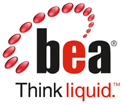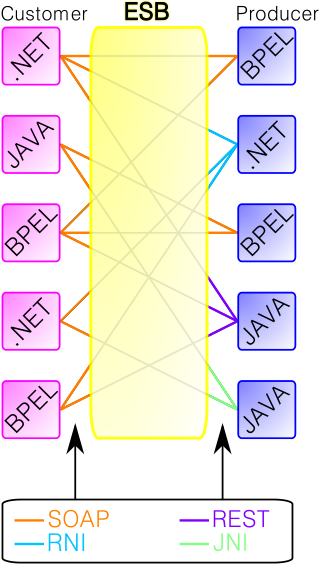In software engineering, multitier architecture is a client–server architecture in which presentation, application processing and data management functions are physically separated. The most widespread use of multitier architecture is the three-tier architecture.

Software architecture is the set of structures needed to reason about a software system and the discipline of creating such structures and systems. Each structure comprises software elements, relations among them, and properties of both elements and relations.
Software design is the process of conceptualizing how a software system will work before it is implemented or modified. Software design also refers to the direct result of the design process – the concepts of how the software will work which consists of both design documentation and undocumented concepts.
A modeling language is any artificial language that can be used to express data, information or knowledge or systems in a structure that is defined by a consistent set of rules. The rules are used for interpretation of the meaning of components in the structure of a programming language.

BEA Systems, Inc. was a company that specialized in enterprise infrastructure software products, which was wholly acquired by Oracle Corporation on April 29, 2008.

The Zachman Framework is an enterprise ontology and is a fundamental structure for enterprise architecture which provides a formal and structured way of viewing and defining an enterprise. The ontology is a two dimensional classification schema that reflects the intersection between two historical classifications. The first are primitive interrogatives: What, How, When, Who, Where, and Why. The second is derived from the philosophical concept of reification, the transformation of an abstract idea into an instantiation. The Zachman Framework reification transformations are: identification, definition, representation, specification, configuration and instantiation.

An enterprise service bus (ESB) implements a communication system between mutually interacting software applications in a service-oriented architecture (SOA). It represents a software architecture for distributed computing, and is a special variant of the more general client-server model, wherein any application may behave as server or client. ESB promotes agility and flexibility with regard to high-level protocol communication between applications. Its primary use is in enterprise application integration (EAI) of heterogeneous and complex service landscapes.
A functional software architecture (FSA) is an architectural model that identifies enterprise functions, interactions and corresponding IT needs. These functions can be used as a reference by different domain experts to develop IT-systems as part of a co-operative information-driven enterprise. In this way, both software engineers and enterprise architects can create an information-driven, integrated organizational environment.
Architecture description languages (ADLs) are used in several disciplines: system engineering, software engineering, and enterprise modelling and engineering.

The ARIS concept by August-Wilhelm Scheer aims to ensure that an enterprise information system can completely meet its requirements.

Unicom System Architect is an enterprise architecture tool that is used by the business and technology departments of corporations and government agencies to model their business operations and the systems, applications, and databases that support them. System Architect is used to build architectures using various frameworks including TOGAF, ArchiMate, DoDAF, MODAF, NAF and standard method notations such as sysML, UML, BPMN, and relational data modeling. System Architect is developed by UNICOM Systems, a division of UNICOM Global, a United States–based company.
The Enterprise Unified Process (EUP) is an extended variant of the Unified Process and was developed by Scott W. Ambler and Larry Constantine in 2000, eventually reworked in 2005 by Ambler, John Nalbone and Michael Vizdos. EUP was originally introduced to overcome some shortages of RUP, namely the lack of production and eventual retirement of a software system. So two phases and several new disciplines were added. EUP sees software development not as a standalone activity, but embedded in the lifecycle of the system, the IT lifecycle of the enterprise and the organization/business lifecycle of the enterprise itself. It deals with software development as seen from the customer's point of view.

An enterprise architecture framework defines how to create and use an enterprise architecture. An architecture framework provides principles and practices for creating and using the architecture description of a system. It structures architects' thinking by dividing the architecture description into domains, layers, or views, and offers models – typically matrices and diagrams – for documenting each view. This allows for making systemic design decisions on all the components of the system and making long-term decisions around new design requirements, sustainability, and support.
Brian Henderson-Sellers is an English-Australian computer scientist. He is a Professor of Information Systems at the University of Technology Sydney. He is also Director of the Centre for Object Technology and Applications at University of Technology Sydney.

The unified software development process or unified process is an iterative and incremental software development process framework. The best-known and extensively documented refinement of the unified process is the rational unified process (RUP). Other examples are OpenUP and agile unified process.

Enterprise modelling is the abstract representation, description and definition of the structure, processes, information and resources of an identifiable business, government body, or other large organization.
Knowledge Discovery Metamodel (KDM) is a publicly available specification from the Object Management Group (OMG). KDM is a common intermediate representation for existing software systems and their operating environments, that defines common metadata required for deep semantic integration of Application Lifecycle Management tools. KDM was designed as the OMG's foundation for software modernization, IT portfolio management and software assurance. KDM uses OMG's Meta-Object Facility to define an XMI interchange format between tools that work with existing software as well as an abstract interface (API) for the next-generation assurance and modernization tools. KDM standardizes existing approaches to knowledge discovery in software engineering artifacts, also known as software mining.
Advanced Numerical Research and Analysis Group (ANURAG) is a laboratory of the Defence Research and Development Organisation (DRDO). Located in Kanchanbagh, Hyderabad, it is involved in the development of computing solutions for numerical analysis and their use in other DRDO projects.
Enterprise engineering is the body of knowledge, principles, and practices used to design all or part of an enterprise. An enterprise is a complex socio-technical system that comprises people, information, and technology that interact with each other and their environment in support of a common mission. One definition is: "an enterprise life-cycle oriented discipline for the identification, design, and implementation of enterprises and their continuous evolution", supported by enterprise modelling. The discipline examines each aspect of the enterprise, including business processes, information flows, material flows, and organizational structure. Enterprise engineering may focus on the design of the enterprise as a whole, or on the design and integration of certain business components.

A view model or viewpoints framework in systems engineering, software engineering, and enterprise engineering is a framework which defines a coherent set of views to be used in the construction of a system architecture, software architecture, or enterprise architecture. A view is a representation of the whole system from the perspective of a related set of concerns.










